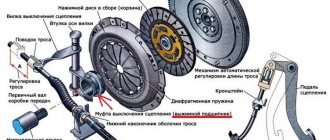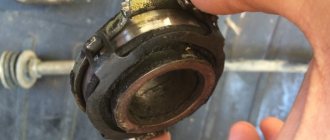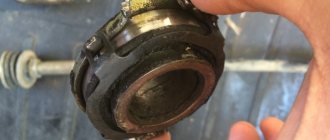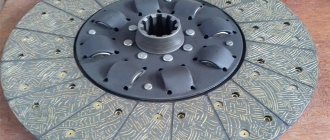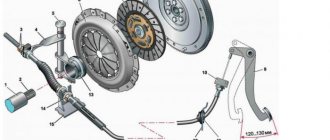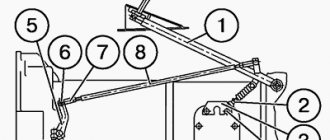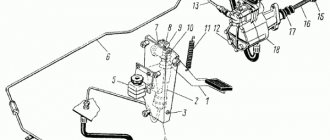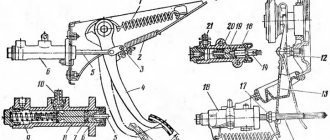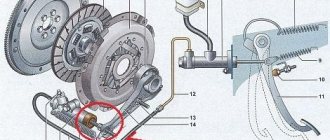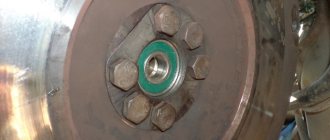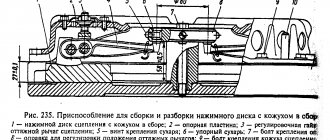Most cars use a clutch consisting of 2 discs. To separate them when changing gears, a release clutch is created. When the car is moving, it is at rest and starts working after pressing the clutch pedal. Failure of this part makes it impossible to operate the car. If there are clear signs of a faulty release bearing, it must be replaced.
Release bearing failure in a car - causes, symptoms
Most cars use a clutch that has 2 discs. In order for them to be separated during gear shifting, a release clutch is provided. When the car is in motion, it does not work. As soon as the driver depresses the clutch pedal, the clutch begins to work. If this element fails, it is prohibited to operate the vehicle. There are certain signs that indicate a faulty release bearing.
Older cars used graphite plain bearings
According to their design, release bearings can be divided into ball and roller. According to the method of force transmission - mechanical and hydraulic. Older cars used graphite plain bearings. In mechanical elements, the part moves using a fork, to which the force is transmitted by a cable. In a hydraulic coupling, the role of the working fluid is performed by liquid.
Passenger cars use a diaphragm spring clutch. It acts as activation levers and coil springs. It is made in a flat form, and has stamped petals on the central part. When you press the pedal, the fork begins to displace the release clutch, which itself presses on the spring. The inner part moves, the middle bends and the edge pushes the pressure plate away - the clutch disengages. When the driver releases the pedal, all elements move in the opposite direction.
Causes of failure . The load on the release bearing is created at the moment when the clutch is disengaged. The higher the engine speed at the moment of gear shifting, the more difficult the operating mode. Let's look at the most common reasons why a part may fail:
1) pressing the clutch pedal for a long time; 2) abrupt engagement/disengagement of the clutch during aggressive driving. Rapid loads are created on the bearing, which lead to failure of the entire assembly, not just the bearing; 3) poor pedal travel adjustment.
There is another reason why a bearing fails. If a motorist purchases consumables for a unit that are not of high quality. This also includes poor quality maintenance - there should always be grease in the release clutch cavity, but some car owners do not know about this.
Signs of malfunction . A malfunction of the release clutch can be determined by certain signs, so it is important to listen to the operation of the car while driving. The first sign is the appearance of extraneous noise when pressing the clutch pedal. When a knot breaks, it is accompanied by a grinding and crunching sound. The second sign is a sticking gear shift drive. In some cases, the problem develops to such an extent that a certain speed cannot be turned on. Another sign indicating a malfunction of the clutch is that the pedal travel is too free. The last thing you can pay attention to is incomplete disengagement/engagement of the clutch. Very often the last sign is accompanied by an unpleasant burning smell. To correct the defect, you can contact the service. If you have the skills and knowledge about the structure of the car, you can try to carry out the replacement yourself. To do this, remove the gearbox and disconnect the fork from the coupling. After this, the bearing is removed from the gearbox input shaft, and the spring retainer is removed from the outer housing of the element. The new part should be checked for quality before installation. It should rotate easily. The presence of lubrication in the system is very important. Assemblies are carried out in reverse order.
Bottom line . The release bearing performs an important function in the clutch system. Its failure is accompanied by the appearance of an unpleasant sound and other symptoms.
Source
Principle of operation
The release bearing can be either push-action or pull-out. It turns the mechanism on and off. The clutch basket is connected to the disc. Today two types of these bearings are produced:
- Roller;
- Hydraulic.
The clutch is used to smoothly disengage the engine from the transmission when changing gears. This approach protects transmission elements from excessive overloads and malfunctions.
One side of the release bearing is made as a round pressure pad, comparable to the diameter of the release springs, located in the center of a part called the clutch basket.
Roller
The release bearing is located on the input shaft protruding from the gearbox, but it is attached to the shaft protective casing and drives the drive fork (rocker arm). The latter presses on a pressure mandrel equipped with special protrusions. The hub moves freely to the input shaft. Damper springs located inside dampen torsional vibrations, they ensure smooth activation.
The pressure plate with the diaphragm spring and the housing form a block called the clutch basket. To create the required force, a diaphragm spring presses on the pressure plate. Inside it is made like metal petals, which are acted upon by a release bearing. It is placed on the axis of rotation as a transmission device connecting the drive to the clutch. The fork (rocker arm) is designed to move the release clutch with the bearing.
Hydraulic
How can you tell if the release bearing is faulty?
Most cars use a clutch consisting of 2 discs. To separate them when changing gears, a release clutch is created. When the car is moving, it is at rest and starts working after pressing the clutch pedal. Failure of this part makes it impossible to operate the car. If there are clear signs of a faulty release bearing, it must be replaced.
Proper bearing performance check
In most car models, manufacturers install release bearings with a high degree of reliability. Thanks to this, during operation, their resource is distributed over a long mileage, because it comes into operation only when the clutch pedal is pressed.
The part is subjected to significant loads during a sharp start, slipping of the drive wheels, and long journeys, for example, on a highway with poor-quality surfaces.
The driver must notice a problem with the release bearing in time in order to carry out preventive work on the clutch in a timely manner. There are no special diagnostic tools provided to determine its performance. Failure can be determined by indirect signs, which differ for mechanical and hydraulic structures.
Obvious symptoms include the following:
- During operation of the gearbox, extraneous noises are heard;
- it is not possible to change speeds freely;
- the clutch slips.
First of all, the clearance of the fork and the working cylinder rod is controlled. Then we find out the condition and performance of the release bearing. We will need to start the engine, depress the clutch, and then analyze the noise. Obvious knocking or whistling sounds that appear while pressing and disappear after returning the pedal to the upper position indicate a bearing failure.
The physical condition of the part can be determined after dismantling the box. You will need to remove it simultaneously with the input shaft guide and the clutch.
During visual diagnostics, we determine permissible backlash, jamming, and damage to the housing. The problem may occur after the lubricant has run out. In this case, we remove the contaminants and fill the assembly with lithol or other suitable lubricant, and then return everything to its place. It is necessary to check the smooth running and quality of rotation. After complete assembly, we check the functionality with the engine turned on.
Often found on a hydraulic structure is such an indirect sign as pedal failure. This is a consequence of the lack of tightness of the drive and the piston on the bearing. Before dismantling the box, the driver is required to check the condition of the working and master cylinders of the drive, and the entire hydraulic wiring of the unit is also monitored. You will need to look into the tank to check the fluid level and also make sure there are no air pockets.
Types of release bearings
Release couplings are divided according to the design of the units into ball and roller and according to the method of transmitting force into mechanical and hydraulic. Older cars (ZAZ, Moskvich 412) used graphite plain bearings. In mechanical units, the part is moved by a fork, to which the force from the pedal is transmitted by a cable. In hydraulic couplings, a special fluid is used as a working fluid; the pedal moves the piston of the clutch master cylinder, which transmits force to the hydraulics. The latter moves the release bearing and disengages the clutch.
Which bearing is better
Many car owners try to replace it with a “original” part from the car manufacturer. But, for example, domestic spare parts from Lada cannot be characterized as the most durable and durable. Popular models are from the German company Sachs or the official supplier for our AvtoVAZ - the Italian bearing Coram. The price leader is Sachs; this is an inexpensive and acceptable quality alternative to replacing a faulty part. You can also choose EXEDY and SASSONE from more inexpensive models.
General operating principle
On passenger cars, a clutch with a diaphragm pressure spring is used. It replaces engagement levers and coil springs. The element has a flat shape, in the central part of which petals are stamped. They also serve as release levers. When you press the pedal, the fork moves the release clutch, which presses on the spring. Its inner part moves forward, the spring bends and with its outer edge retracts the pressure plate, disengaging the clutch.
When the pedal is released, the parts move in the reverse order. The spring returns to its original state and the clutch engages. Such a device is cheaper than a product with levers and requires fewer adjustments after repair.
Part location
The release bearing, which serves to separate the engine and transmission, is located on the journal of the gearbox input shaft. When you press the pedal, the part moves freely along the shaft towards the clutch pressure plate.
On the back of the bearing there is a spring that holds the fork and prevents the device from rotating. The part consists of the following elements:
- inner race;
- rolling elements (balls or rollers);
- outer casing with a thrust heel and a spring.
The fork fits into the gearbox mount and is secured to the outer bearing housing. On the other side, a cable is attached that transmits force from the clutch pedal.
Possible causes of failure
Loads on the release bearing occur when the clutch is disengaged. The higher the engine speed at the moment of gear shifting, the more intense its operating mode. The most common reasons for part failure are:
- Holding the clutch pedal down for a long time. High rotation speed and large axial forces from the diaphragm spring lead to rapid wear of the device elements.
- Abrupt engagement and disengagement of the clutch. Characteristic of aggressive driving style. Instant uneven loads occur on the bearing, which can lead to failure of not only the rotating part and the pressure fork, but also the clutch elements.
- Poor adjustment of pedal or cable travel. The bearing is in constant contact with the surface of the spring. Constant rotation causes heating of the rolling elements, which leads to rapid wear.
Part destruction may occur due to the installation of a low-quality product or lack of grease in the release clutch cavity.
Causes of premature wear
On average, the clutch on a car can last about 100-150 thousand kilometers. Much depends on the style and experience of the driver.
When the clutch pedal is lowered, the disc engages with the flywheel and basket. Slippage and gradual abrasion occur. There's nothing wrong with that. A completely natural process.
But newbies behind the wheel often act too aggressively and ineptly. Because of this, they stall at the start and have difficulty switching.
The release bearing only comes into play when the pedal is pressed. Therefore, the service life is directly related to the intensity and accuracy of use of the pedal.
The longer the pedal is pressed, the faster the bearing will wear out. It is because of this that novice and aggressive drivers are quicker than others to face the need to replace this component.
Signs of malfunctioning parts
The release clutch can fail not only due to improper use, but also due to natural wear and tear. Knowing the operating principle of the device, you can determine its technical condition based on its characteristic symptoms. Typical symptoms of a malfunction are:
- The occurrence of extraneous noise when pressing the clutch pedal. The destruction of the node is accompanied by a grinding or loud crunch.
- Gear shift drive sticking. Sometimes it is impossible to turn on the desired speed.
- Excessively free play of the clutch pedal.
- Incomplete engagement or disengagement of the clutch. The situation may be accompanied by an unpleasant burning smell.
Additional signs of a breakdown are: increased fuel consumption, engine overheating, and jerky movement of the vehicle. The service life of the part is reduced due to dust and dirt getting into the bearing, increased temperature and lack of lubrication.
Signs of a defect cannot be ignored, because... This can lead to serious consequences when driving with a faulty transmission.
Control check
You can diagnose the condition of the squeezing device in the following way:
- Start the car engine. Listen to your work for any extraneous noise. If available, determine the location.
- Depress the clutch pedal. If an extraneous sound appears, the part will need to be replaced.
The bearing cannot be repaired. The problem is solved by replacing the defective part.
Consequences of malfunction
The element has sufficient strength, so it cannot fall apart instantly. However, there is no point in delaying the elimination of the defect, since failure leads to misalignment of the disks and uneven wear. As a result, problems will arise with the transmission, which will negatively affect the technical condition of the vehicle.
If the part falls apart, the driver will not be able to engage the desired gear and move away. If such a defect occurs while the vehicle is moving in the city, the services of a tow truck will be required.
Diagnosis of clutch faults
You can check the performance of the coupling using simple and reliable folk methods. Naturally, we are not talking about disassembling the entire mechanism, but about how to independently check the clutch and, based on the data, make a decision about the need for in-depth diagnostics followed by dismantling.
"Drives" the clutch
In the case when the discs do not completely separate when pressing the clutch pedal, the clutch is said to have “engaged”. This means that they have some kind of contact, so the clutch is not completely turned off. Experienced car owners know how to check the mechanism for complete shutdown.
Diagnosis is quite simple. To do this, at low speeds with the pedal fully depressed, first gear is engaged. If such an action was carried out easily and was not accompanied by extraneous noise, the shutdown occurred completely. In case of difficulty in switching, which additionally caused gear noise, it means “drives”.
To eliminate the causes you will need:
- adjust the drive;
- clean and lubricate the splines;
- repair or replace the driven disk;
- replacing friction linings.
Any mechanism has to be changed sooner or later. In a hydraulically driven system, you will need to pump it to remove any accidentally trapped air, check the tightness of the connections and the integrity of the pipes. If necessary, replace parts that have failed (for example, the main or working cylinder in case of a fluid leak).
Clutch “slips”
If while driving you heard the smell of burnt oil, and on uphill slopes the car began to noticeably lose speed, and in general the dynamics deteriorated significantly, then no diagnostics are needed. Verdict - the clutch is slipping.
This indicates that the drive and driven disks do not mesh tightly enough when turned on. There is one very simple and accessible way to check the operation of the mechanism. To do this you will need:
- put the car on the handbrake and start the engine;
- Depress the clutch pedal and engage gear;
- smoothly press the gas pedal and then also smoothly release the clutch.
The engine should stall. Otherwise, the clutch slips. Defects can be eliminated by adjusting the drive and replacing the linings. Rubbing parts that have been exposed to oil should be thoroughly cleaned with a solvent (for example, white spirit). Then determine the reason for the lubricant getting into the mechanism and eliminate it.
Checking clutch wear
Checking the degree of wear of the driven disc is also a fairly simple task, which will tell you whether it is time to change the clutch or not. To do this, you need to start the engine and engage first gear. Then try to move away without accelerating. This will help you understand the condition of the clutch disc:
- the clutch “grabs” at the very beginning - the disc is in excellent condition, the mechanism is fully operational;
- The clutch “suffices” approximately in the middle - the disc is worn out by half or needs adjustment;
- The clutch “grabs” only at the end of the pedal stroke - the disc must be replaced.
In some cases, the disc is not yet completely worn out, and normal clutch operation is restored by simply adjusting the appropriate nuts.
How to change the clutch bearing yourself?
When replacing any part of the clutch mechanism, it is recommended to install a new release device. Its price is low, so you shouldn’t skimp on buying a part, even if it has not reached its intended service life. The work of replacing the clutch release bearing is not too complicated, so you can do it yourself if you have the necessary tools and some repair skills. To install a new part, you need to perform the following steps sequentially:
- Remove the gearbox and disconnect the pressure fork from the clutch.
- Remove the bearing from the transmission input shaft.
- Remove the spring clip from the piece of the outer body of the part.
- Check the new part for ease of rotation and presence of lubrication.
- Install the spring retainer onto the coupling.
- Place the assembly onto the gearbox shaft.
- Connect the plug to the coin and secure with a spring.
- Reinstall the gearbox.
After assembly is completed, adjust the drive if necessary . To check the operation of the replaced unit, you need to start the engine and squeeze the clutch. If no extraneous sounds are heard, it means the work was done correctly.
Replacing a unit at a service station should be carried out in cases where there is no confidence in the quality of the operation with your own hands.
Replacement and repair
You can replace a failed release bearing yourself. Having little experience in car repairs, I carried out this procedure quite quickly. First of all, I remove the gearbox and disengage the spring clip. I remove the bearing from the guide sleeve. Using tools, I press out the “legs” of the spring holder and remove the part. Before installing a new one, I check it with special care. It’s better to carefully look and feel everything than to redo the work twice. It is not permissible for the bearing to seize; its rotation should be easy, without backlash.
When installing a new part on the coupling, I carefully ensure that the part of the inner ring that protrudes is facing to the side. It is easy to fix with a holder. I apply lubricant to the guide bushing and only then replace it with another one. It and the coupling are secured using a spring clamp. I put the checkpoint in place.
The new spare part will work properly up to 150 thousand km. mileage But it is often necessary to replace the release bearing every 50 thousand km. due to driver errors and poor road surfaces.
Resource extension
Warranty obligations do not apply to parts that fail early, because its wear and tear depends entirely on the actions of the driver. However, there are several recommendations that, if followed, will extend the life of the unit.
To extend the life of a part you need:
- avoid abruptly moving the car;
- do not allow the pedal to be slowly released at high engine speeds;
- drive with the clutch pedal fully released and do not press it while braking;
- Avoid situations in which the car may slip.
But the main recommendation is to minimize holding the pedal down for a long time. The release mechanism will last longer if the clutch pedal is used only to change speed.
Source
Malfunctions
If the release bearings are damaged, then extraneous noise appears in the operation of the shafts.
To find out what the malfunction is, you need to depress the pedal (the engine is running). If after this the noise disappears, then the part is not at fault. These signs indicate problems with the gearbox and it needs to be repaired. When the noise continues to intensify, the fault is related to the bearing and it urgently needs to be replaced.
Torque acts on the clutch release bearing only at the moment of pressing. When the pedal is depressed, it goes back together with the driven disc (clutch basket). And then, if the gear is engaged and the pedal is held down for a long time, then uneven loads act on the part. This usually leads to rapid wear, but if all operating rules are followed, repairs will not be needed for long.
But the knocking sound when the clutch pedal is depressed (the engine is running) can intensify in cold weather. Then it's quite possible there's no need to worry. This part is made of heavy-duty steel with a low linear expansion coefficient. The glass, where all the bearing elements are located, is, on the contrary, subject to temperature influences, so knocking may occur periodically. This does not indicate a system malfunction
What happens when the release bearing breaks?
Maltus, you are a journalist, right? Then I’ll write briefly and clearly (simplified) 1. First of all - diagnostics: The noise of the release lever can be rustling, humming, rumble - depending on the degree of wear. It is diagnosed very simply - it makes noise relatively rarely on its own (for bores, there are exceptions). If with the engine running (the car is stationary) and the clutch pedal is depressed, the noise SHARPLY intensifies and/or changes, this is it. 2. Consequences - in advanced cases - the end of the clutch (basket), sometimes the fork too. Serozhka described everything correctly to you. 3. Options for action - depending on the degree of wear, but keep in mind that this unit can only be accurately and correctly diagnosed by removing it, so it is more advisable to replace the entire clutch kit assembly, even with slight wear. Repeated removal of the box after 3-5 t.km. to replace the basket (or a new releaser - a chewed basket can easily “finish it off”) will negate all the savings of replacing only the bearing. You can (deciding that you need to change the entire clutch kit anyway) drive to victory, then be prepared for the following development of events: The clutch release usually breaks first, and it VERY RARELY jams, i.e. You can change gears, but without problems they only shift when the engine of the car is stopped. Then you can start in first, then shift without pressing the clutch, adjusting the crankshaft speed with gas. You can practice this skill now. In this case, you will save a few rubles by replacing everything at once, and you can drive a long time before replacing it. 4. The most interesting thing is that it may not be a squeeze. Then the scenario becomes much more complicated.
And lastly, try to write correctly and correctly. If you specifically “play assholes,” that’s one thing; if not, buy a dictionary. And DO NOT interfere with the machine working. Entrust the diagnostics to professionals (at least just experienced people). Here - as a doctor, you should never be nervous, it’s better to think, get the opinion of another doctor, etc. And self-medication - “it’s good and cheap to treat yourself according to a book, but it’s scary and expensive to die from an illness.” Be prepared to pay for the consequences of doing your own repairs.
And don’t be offended by the grumbler - I’m not out of malice.
Source
How to determine the breakdown of the release bearing, causes and symptoms of malfunction
The release bearing is one of the main clutch elements in a car. Its wear and tear will lead to system malfunctions, resulting in the need to replace the device. In this article we will talk about what signs of malfunction are typical for a release bearing and what the failure of this part can mean for the car.
Types of release bearings
Causes and signs of failure
How to check a release bearing
Changing the release bearing
Consequences of failure
Video “Guide to replacing and lubricating parts”
Adjusting the clutch system and release bearing
If the clutch mechanism is not working properly, the car moves jerkily, jumpily, the lever sinks, and various sounds are emitted from the box.
Good performance properties of a car depend on the quality of operation of three motion systems: gas, brake and clutch mechanisms. To adjust the clutch, sometimes it is enough to adjust the drive; in other cases, repair and replacement will be required. Adjustments must be made on time to avoid breakdowns that require large financial costs. The main signs of a malfunctioning clutch mechanism: the car moves jerkily, jumpily, the lever sinks, various sounds the gearbox Ideally, after depressing the pedal, the car should move slowly and smoothly. Sometimes a lot depends on the little things, and it would seem that such a small part of a large machine, like a release bearing, is a drop in the bucket. But in practice, everything is not so; even the smallest particle that has become unusable requires attention. An experienced driver will be able to repair or replace the release bearing; a beginner will most likely go to the nearest service station or try to solve the problem on his own by reading this article. Good luck on the roads!
1200 rub. for the photo report
We pay for photo reports on car repairs. Earnings from 10,000 rubles/month.
Write:
Today, the most common clutch systems have two discs - a leading one, rigidly coupled to the crankshaft, and a driven one, transmitting torque to the gearbox. To change gears or put the car into idle speed, the clutch discs must be disconnected, which is done using a release bearing that pulls the driven disc away from the drive disc.
Release bearing location
This is an important element of the clutch system, and at the same time one of the most vulnerable parts. The clutch release bearing is at rest while the vehicle is moving, and only comes into operation when changing gears. The breakdown of such a small spare part guarantees the impossibility of further operation of the car, so the bearing must be changed immediately when obvious signs of its malfunction appear.
The part costs from 300 to 1500 or more rubles, depending on the manufacturer and model of the car. Replacing a bearing at a service station will cost 3,000-7,000 rubles, so if you have the desire, opportunity and a normal set of auto tools, it makes sense to do it yourself and save a lot of money.
Types of release bearings
Before we find out the reasons for the failure and what problems the wear of the bearing device will bring for an Accent car or another model, let’s look at the types of parts.
Today, two types of devices are used in clutch and gear shift systems:
- Ball or roller. Mechanical parts during operation of which force is transmitted through a rigid bunch of rods.
- Hydraulic elements. In such devices, force is transmitted via hydraulics. This allows the driver to depress the clutch pedal more easily. Almost all new cars are equipped with hydraulic bearings.
- Mechanical. Practically not used. Previously, Russian-made cars were equipped with such parts.
Operating principle
The purpose of the device is to ensure uninterrupted connection and disconnection of the clutch discs when the driver presses the pedal.
The operating principle is as follows:
- Through the action of the pressure plate, the driven shaft is pressed against the clutch flywheel.
- The system generates pressure, which is applied to the pressure shaft; this is ensured through the use of a diaphragm spring. Its inner petals are affected by a bearing device.
- The part moves, resulting in separation of the shafts through the action of the fork.
User Alexey Romanov published a video that will help you understand the principle of operation of the clutch system and release bearing.
Causes and signs of failure
If the bearing has fallen apart or is just failing, this will lead to problems with the clutch system.
If a bearing fails, it is usually because the unit has worn out from constant use under high loads. Often the cause of a worn and broken unit is holding the clutch pedal in gear for a long time. When a driver makes such a mistake while idling in traffic jams, heavy loads are placed on the device, which leads to its breakdown. Why other parts fail is due to natural wear and tear. If the bearing element is faulty, this can be determined by certain symptoms.
What are the typical signs of failure for a release bearing?
- The main sign of a failed component is the appearance of extraneous sound. This is usually a noise or knocking noise that can be heard when you depress the clutch pedal of your car. The type of sound may vary. Sometimes the device makes a quiet noise, crunches, crackles or knocks loudly. The louder the sound, the more likely it is that the device has worn out and fallen apart.
- If the part does not squeak, signs may manifest itself in difficulties in operating the machine. Sometimes the driver fails to reach a certain speed. In some cases, when the car starts moving, it jerks uncharacteristically.
- Slipping or incomplete disengagement of the clutch. When the driver releases the pedal, slippage occurs and a burning smell appears.
- The pedal free play has increased. The dynamics of the vehicle deteriorate, the car moves unevenly.
- Sometimes the failure of the release bearing leads to increased fuel consumption and even overheating of the engine.
Changing the release bearing
More information on how to remove and dismantle the bearing device from the coupling:
- Remove the gearbox. This will provide free access to all components and elements of the transmission and clutch system.
- Disengage the spring fastening from the coupling. To do this, use a screwdriver or other available tool.
- Dismantle the failed release bearing from the guide bushing. To do this, you will need to press out the 4 latches of the spring fastening and remove it. After removing the device from the coupling, carefully inspect the device for any defects or malfunctions. Make sure that the part has failed and needs to be replaced.
- Before changing and installing a new bearing, it must be checked. Delays during rotation of the device are not allowed, as are gaps. If the part is operational, then replace the coupling. When installing, make sure that the inner protruding part of the ring is directed to the side. After installation, the element must be secured with a fastener.
- Lubricant is applied to the guide, after which the bearing device is installed. The part is secured using a holder.
- The removed gearbox is installed and the functionality of the device is checked.
Removing the gearbox
The procedure for dismantling the gearbox can be performed differently depending on the design features of the machine. Removal of the unit should be carried out with an assistant. Before dismantling, the vehicle battery is disconnected and removed, as well as the transmission fluid is drained.
How to remove the gearbox:
- Disconnect the clutch pedal cable. Remove it from the bracket.
- Disconnect the block with wires from the speed sensor installed on the box. Be careful not to damage the connector. To turn it off, press the latches.
- Using a wrench, unscrew the bolts that secure the ignition module bracket to the gearbox. Also unscrew the screws securing the transmission to the power unit.
- You will see connectors on the bottom of the gearbox; they need to be disconnected.
- Remove all screws that secure the torque rod bracket to the transmission housing. It is necessary to loosen the clamp of the rod clamp, which is designed to change gears. Disconnect this element from the hinge.
- Dismantle the wheel drives. Remove another nut that secures the transmission to the engine.
- Unscrew the three screws and remove the gearbox housing cover. It remains to unscrew one more bolt that secures the unit to the engine.
- Under the bottom of the car, find the nuts that secure the left and rear engine support of the car. After this, the gearbox must be carefully moved along the guides. Dismantling the gearbox is carried out with the help of a partner. Replace the release bearing and reinstall the gearbox. Fill with new oil.
Solving the problem
There are many reasons for clutch failure, but in this article we will describe one of the most common, namely the failure of the release bearing.
Release bearing
The release bearing is an important part, and any car owner should know how to prevent it from breaking and malfunctions, and if this happens, how to replace it correctly.
Causes of failure
The release bearing is influenced only when the pedal is depressed, at which point it is pulled back, as if it were moving the driven disc. As a result, if you hold the clutch for a long time at the engaged speed, there is a load on the bearing, which can cause rapid wear or malfunction. However, if used correctly, no repairs will be needed.
Has your release bearing failed?
Survey
- No (100%!, 1 Vote)
- Yes (0%!, 0 Vote)
Total votes: 1
Loading …
Signs of release bearing failure
Symptoms of wear on the release bearing are typical knocking noises when pressing the clutch while the engine is running. But if this knocking noise mainly increases at low temperatures, then there is no need to worry. Because this part is made of very strong steel, which has relatively low expansion. The glass in which the bearing itself is located, on the contrary, is very sensitive to temperature changes.
Changing the release bearing
To make a replacement you must:
- Remove the gearbox (removing the gearbox will be described below).
- The ends of the clamp disengage from the coupling.
Disconnect the clamp from the coupling
- Remove the bearing from the sleeve along with the coupling.
Removing the coupling
- Remove the bearing from the coupling on which it is located.
Squeeze the petals and remove the bearing
- Carefully inspect the bearing you are about to install. Rotation in it must occur freely, backlash is unacceptable.
Before installation, inspect the condition of the new bearing
- When installing a new one on the clutch, make sure that part of its inner ring is directed to the side.
- Secure it in this position - a special lock is provided for this.
- Lubricate the bushing with grease.
- Install the bearing.
- The coupling must be secured with a special clamp.
- Install the gearbox.
Removing the gearbox
Advice: it is better to remove the gearbox with a partner.
Before removing the gearbox, it is necessary to remove the battery and drain the transmission oil, and the starter must also be disconnected. These procedures are simple, so we will not dwell on them in detail.
- Disconnect the clutch cable and remove it from the bracket.
- We disconnect the block from the speed meter; to do this, you need to compress the spring clips.
Disconnecting the block
- We unscrew the bolts securing the ignition module bracket to the gearbox and the bolts securing the gearbox to the engine.
- At the bottom of the car, disconnect the wires connecting the block to the light switch.
- We unscrew the bolts attaching the torque rod bracket to the gearbox.
Unscrewing the bracket mounting bolts
- We loosen the fastening of the traction clamp, which is responsible for shifting gears.
- Disconnect the rod from the speed selector rod hinge.
- We remove the wheel drives.
Removing the wheel drives
- Unscrew the nut securing the gearbox to the engine.
- Unscrew the 3 bolts and remove the crankcase cover.
- We unscrew the bolt connecting the gearbox to the engine.
Unscrewing the bolt securing the box with the motor
- From the bottom of the car, unscrew the nut securing the left power unit support.
- Unscrew the nuts securing the rear support of the power unit to the body.
- Carefully slide the box along the guide bushings.
How to extend the resource?
To increase the service life of the device, you must drive on smooth roads. In our country, it is problematic to comply with this condition. Keep in mind that uneven roads destroy not only the vehicle’s chassis, but also the clutch system. Therefore, regular off-road driving is also dangerous for bearings. Don't make mistakes when operating your car. When the car is stopped at a traffic light, there is no need to depress the clutch pedal and engage first gear if you do not plan to move. This should only be done at the beginning of movement, since the part operates under high load conditions. Regular lubrication will increase the service life of the device.
Purpose
To understand where the release bearing is located, you need to understand the purpose and design of the clutch. The clutch and all its parts belong to the vehicle's transmission. It ensures the transmission of torque from the engine to the drive axle and wheels, and must be located between these parts of the machine. But an important condition for the location is accessibility in its control by the driver. Most often this is the clutch pedal, less often the lever near the steering wheel. Using the clutch mechanism, the driver periodically disconnects the engine from the transmission. This allows you to stop the car, change the gearbox, and change the driving dynamics.
